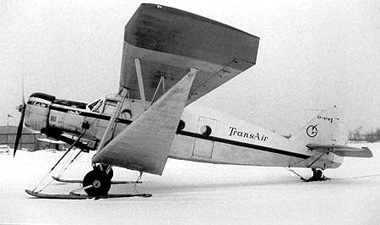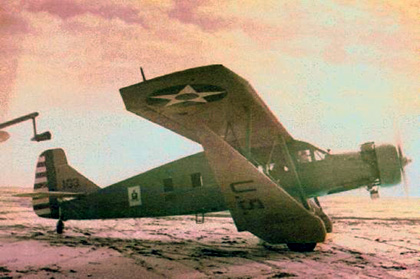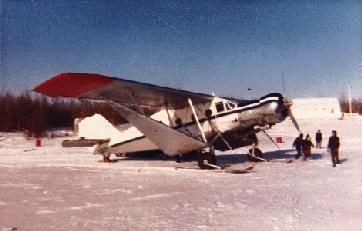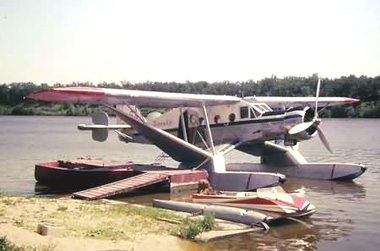History
The Aircruiser design was created for a purpose. In 1928, aviation was setting records right and left and an Italian WW I ace, Caesare Sabelli, commissioned a design for a plane that would be able to to fly non-stop from New York to Rome. Giuseppe Bellanca, a gifted designer, came up with the Model K , which never made that flight, but the design survived. The distinctive silhouette of the plane is derived from the aerodynamically shaped triangular lifting struts extending down from the bottom of the fuselage and continuing up to a point outboard the main wing.
23 Airbus/Aircruisers were built, all told. The first Bellanca Aircruiser was built in 1930. It was originally called the Airbus and designated the P-100. An efficient airplane design, it was capable of carrying 12 to 14 passengers(later versions differed in being able to carry 15)depending upon how the cabin interior was arranged. In 1931, test pilot George Haldeman flew the P-100 a distance of 4400 miles in a time aloft of 35 hours. Although efficient, with a cost/mile figure of .08 cents/mile calculated for that flight, the first Airbus didn't sell due to its water-cooled engine. This was followed by the P-200 Airbus, with a larger, more reliable air-cooled engine. One version available( the P-200-A) came with floats and operated as a ferry service in New York City, flying between Wall Street and the East River. Other versions included a P-200 Deluxe model, with custom interiors available and seating for 9, as well as the P-300 which was designed to carry 15 passengers. The final model, the Aircruiser, was the most efficient airplane of its day and even would rank high among all airplanes designed. With a Wright aircooled supercharged radial engine (Cyclone), rated at 715 hp. the Aircruiser could carry a useful load greater than its empty weight! It could carry 4,000lb payloads at a speed of between 145-155 mph. This was in the mid-1930's; Fokkers and Ford Trimotors could not come close to this capacity, and they were both multi-engine airplanes.
So why isn't this flying W a more recognizable shape in US aviation history? Three reasons, I feel. First, when Charles Lindbergh and his backers were looking for a plane to win the $25,000 Orteig prize, a Bellanca plane, the WB-2, a powerful, proven performer and race winner was first considered. Unfortunately, the chairman of the board for the Columbia Aircraft Corporation (G. M. Bellanca's aircraft firm), Charlie Levine, proved to be too much of a wheeler-dealer. Bellanca was all for selling the plane to Lindbergh in order that he might make the New York to Paris flight, but Levine had other ideas. He agreed to sell the plane to Lindbergh for $15,000. When Lindbergh arrived to purchase the plane, Levine told him, "...We will sell you the plane, but we reserve the right to select the crew who flies it." Naturally, Lindbergh was furious. He left New York City and the Columbia Aircraft Corporation, went straight to San Diego, and purchased the Ryan plane in which he successfully completed his historic flight.
It is only speculation, but one has to imagine what the boost in prestige and attention to Bellanca and his airplane designs, might have done to his company ultimately. As it was, after two weeks of bickering between Levine and his pilot, Clarence Chamberlin, over both crew and what equipment would be on the plane; the plane Lindbergh refused to buy, Miss Columbia, flew from New York to Berlin, the first plane to do so. In 1931 a version of this same model, Miss Veedol, was the first plane to cross the Pacific.
Another reason would be the time of the early 1930's. Not a time for a robust airline passenger market that could have supported a plane which would have been a successful pioneering passenger plane design.
Finally, in 1934, Federal regulations outlawed single engine transports on US airlines. No one of these factors was responsible more than the other, but the cumulative effect did its damage. Canadian interests utilized several of the Aircruisers and the Bellanca Aircruiser, known in Canada popularly as, "The Flying W" was used in mineral mining, both ferrying supplies and ore, for quite some time. The last flying Aircruiser, CF-BTW, served into the 1970's! It was purchased 2 years ago and flown from Manitoba to Oregon, where it is now on display at the Blimp Hangar Museum NAS, in Tillamook, Oregon.
Vital Statistics
These are for the Airbus (YIC-27), originally powered by a Wright "Cyclone" engine of 650hp, the military models (YIC-27,A, B, C) were powered by, respectively: a geared 550hp, P/W "Hornet" ; R-1820-F, "Wright" Cyclone" or S3D1-G, P/W "Hornet" both 650hp; 675hp, Wright "Cyclone" F; 750hp, Wright "Cyclone".
It began to be referred to as the "Aircruiser" after 1934 and when they began to be fitted with the 670hp Wright "Cyclone" powerplants on up.
- Model: Bellanca
- Designation: C-27
- Version: A
- Name: Airbus
- Type: Cargo/Transport
Specifications
- Length: 42' 9"
- Height: 11' 6"
- Wingspan: 65'
- Wing Area: 520 sq. ft. (approx.)
- Weight: 6,072 lbs.
- Gross Weight: 10,000 lbs.
Propulsion
- No. of Engines: 1
- Powerplant: Wright Cyclone 1820-F
- Horsepower: 650 hp
- Performance
- Range: 570 miles
- Cruise Speed: 115 mph
- Max. Speed: 136 mph
- Ceiling: 14,500 ft.
Current
They Also Flew: The Enlisted Pilot Legacy, 1912-1942 by Lee Arbon. An in depth recounting on a little known situation in the early aviator corps in which enlisted men were also pilots. Includes several stories of pilots' stories of flying the C-27 and how those planes came to be a part of the early Air Transport Command.
Runway to the Sun by Colonel Robert L. Scott, Jr. is a nostalgic accounting of a between the Wars pilot's experiences. There are several flights mentioned in the C-27 his base is assigned for transport (Albrook Field, Canal Zone). Thank you Robert Taylor of the Antique Airplane Association for telling me about this book.
Delaware Aviation History by George Frebert is available. This sounds like it will be a noteworthy Bellanca history source; 384 pages, 370 photographs published for the first time. I know that there will be at least one chapter on G. M. Bellanca exclusively...Mr. Frebert has been someone who I've been in contact with for several years now and has given me help with my searching for material. I'm looking forward to getting a copy. Cost is $40, plus $5 s/h. The publisher is Dover Litho Printing Company, 1211 N. DuPont Highway, Dover, DE 19901, make checks out to them. Print run is 2,000 copies, signed copies are available.
"Bellanca C. F. : The Emergence of the Cabin Monoplane in the United States" , is a very good source to add to your understanding of Bellanca and his airplanes.
Bellanca Airbus / Aircruiser / C-27 Links https://www.bellanca-championclub.com/menander/aclinks.html
Reminiscences | Bellanca Links | Bibliography, Reference Materials, Sources, Etc.
Bellanca C-27
The Canadian Aviation Historical Society was one of the first places I wrote to in researching this airplane. Without their help and information, this page wouldn't be as complete or as interesting as it is. Robert W. Bradford, the artist for the painting of "The Big Bellanca" (see image on this page), is the patron of the CAHS, as well as retired director of the National Aviation Museum.
Western Canada Aviation Museum has its own page dedicated to bush flying in Canada. It's worth noting that their logo is an Aircruiser silhouette. They have 4 photographs of Aircruisers on their site.
Manitoba Aviation Page. Gimli, MB, was the last home for CF-BTW before it was sold to the Tillamook Naval Air Station Museum, new home of the last flying Aircruiser, the former CF-BTW.
Aero Data Files has a very impressive collection of Bellanca data.
Reality Software [website unavailable] has a nice shot of NC 10796, the Airbus owned by the La Touraine Coffee company. This photograph was taken some time in the 1930's at the Owl's Head Airport in Rockland, Maine. They also have other photographs and products in their Historic Transportation section.
The A. J. Jackson Photographic Collection has a photograph listed in its collection for a C-27A.
Harley's Place (now offline) had a set of hand drawn plans for the USAAC C-27 version of the Aircruiser. If anyone finishes one and wants to show it off, let me know and I'd be happy to add a link to your page or add a scan of your handiwork.
The Toon Tracker Homepage, has an episode of this late 50's unique cartoon, which featured the characters flying in a Bellanca Airbus.
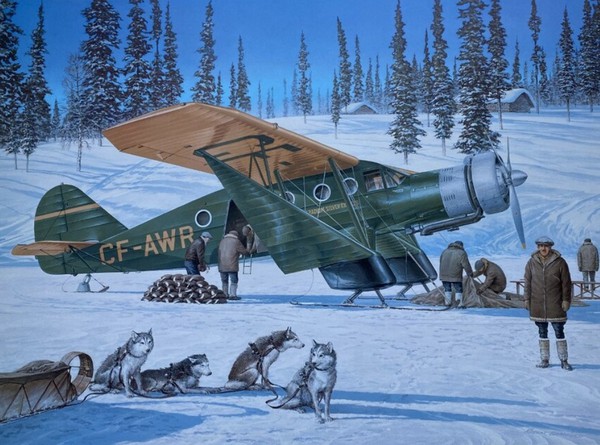
The Big Bellanca "Bush Pilot Series" by Robert Bradford
"The Bellanca Air cruiser CF-AWR is prepared for flight as it rests on the frozen surface of Cameron Bay, Great Bear Lake, N.W.T. during the winter of 1937-38. Aviation Hall of Fame bush pilot Stan McMillan checks the ice condition on the bay as the engine cover is removed from the 660HP Cyclone engine and the ore concentrate bags are loaded into the cabin"
One of the most unusual aircraft to appear in Canadian skied was the big Bellanca, sometimes affectionately known as the flying "W". Five of these huge single-engine cargo aircraft were imported into Canada by operators attracted by their load-carrying capacity, reliability, and performance. By the early 1930's, Sicilian born Guiseppe Mario (or "Joe") Bellanca had already proven his design skills with his highly successful single-engine cabin monoplanes that quickly established international endurance and long-distance records. His CH-300 Pacemaker series had also made a name for itself as an efficient and dependable light transport or "bush plane" in remote regions.


